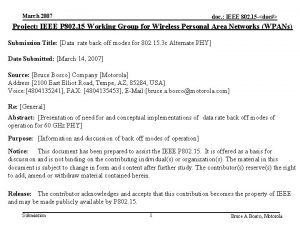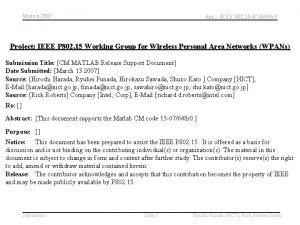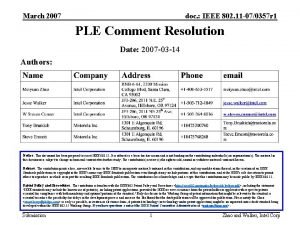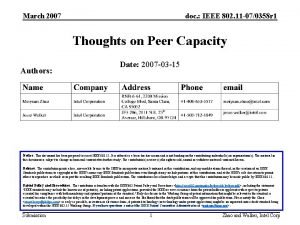March 2007 doc IEEE 802 22 070126 00






- Slides: 6

March 2007 doc. : IEEE 802. 22 -07/0126 -00 -0000 DTV Signal Sensing Using The PN 511 Sequence IEEE P 802. 22 Wireless RANs Date: 2007 -03 -11 Authors: Notice: This document has been prepared to assist IEEE 802. 22. It is offered as a basis for discussion and is not binding on the contributing individual(s) or organization(s). The material in this document is subject to change in form and content after further study. The contributor(s) reserve(s) the right to add, amend or withdraw material contained herein. Release: The contributor grants a free, irrevocable license to the IEEE to incorporate material contained in this contribution, and any modifications thereof, in the creation of an IEEE Standards publication; to copyright in the IEEE’s name any IEEE Standards publication even though it may include portions of this contribution; and at the IEEE’s sole discretion to permit others to reproduce in whole or in part the resulting IEEE Standards publication. The contributor also acknowledges and accepts that this contribution may be made public by IEEE 802. 22. Patent Policy and Procedures: The contributor is familiar with the IEEE 802 Patent Policy and Procedures http: //standards. ieee. org/guides/bylaws/sb-bylaws. pdf including the statement "IEEE standards may include the known use of patent(s), including patent applications, provided the IEEE receives assurance from the patent holder or applicant with respect to patents essential for compliance with both mandatory and optional portions of the standard. " Early disclosure to the Working Group of patent information that might be relevant to the standard is essential to reduce the possibility for delays in the development process and increase the likelihood that the draft publication will be approved for publication. Please notify the Chair Carl R. Stevenson as early as possible, in written or electronic form, if patented technology (or technology under patent application) might be incorporated into a draft standard being developed within the IEEE 802. 22 Working Group. If you have questions, contact the IEEE Patent Committee Administrator at patcom@iee. org. > Submission 1 Monisha Ghosh, Philips

March 2007 doc. : IEEE 802. 22 -07/0126 -00 -0000 PN 511 Sensing • Before correlation can proceed, rudimentary carrier recovery needs to be implemented. • Since timing is unknown, correlation should be done with the complex signal. • Pilot value needs to be either subtracted from the received signal, or added to the reference signal. – Adding the pilot to the reference signal is preferable, since it is difficult to get a reliable estimate of the pilot amplitude at low SNR. Submission 2 Monisha Ghosh, Philips

March 2007 doc. : IEEE 802. 22 -07/0126 -00 -0000 Algorithm Steps • DTV Signal: x(t), at low IF (5. 38 MHz in captured signals). • Perform carrier recovery, estimate fc • Demodulate: y(t) = x(t)e-j 2 p fct. Note that y(t) is a complex signal with the pilot nominally at DC. • Matched filter: filter y(t) with a SQRC filter, to get z(t) which is still complex. • Reference signal is generated by adding pilot value (1. 25) to the +/5 of the PN 511 sequence and upsampling to 21. 52 MHz. • Correlate z(t) with the reference (complex output). • Take absolute value of the complex correlation and compare to a threshold. Submission 3 Monisha Ghosh, Philips

March 2007 doc. : IEEE 802. 22 -07/0126 -00 -0000 Frequency Domain Steps x(t) -5. 38 0 5. 38 y(t) -8. 07 0 z(t) 0 Submission 4 Monisha Ghosh, Philips

March 2007 doc. : IEEE 802. 22 -07/0126 -00 -0000 Performance Of PN 511 Detection Submission 5 Monisha Ghosh, Philips

March 2007 doc. : IEEE 802. 22 -07/0126 -00 -0000 Observations • Difference in performance between best and worst channel is about 2 d. B at PMD = 0. 1 and about 3 d. B at PMD = 0. 01. • The worst channel is WAS_49_39_06142000_opt, which has a very weak pilot carrier. – Is performance bad due to incorrect carrier recovery? • This method is amenable to any IF and sampling rate. – The reference signal is up-sampled to match the sampling rate of the received signal. • Combining of peaks from multiple fields can be done as described in IEEE-802. 22 -06/243 r 5, using the method described here to obtain the correlation for each field. Submission 6 Monisha Ghosh, Philips










